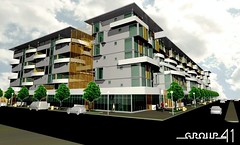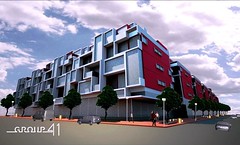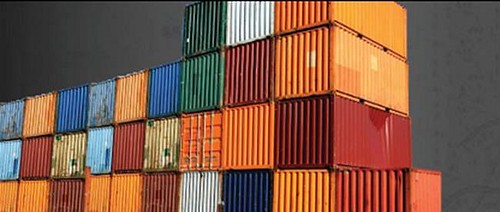Development that is both transit-oriented AND transit-derived!

Posted April 15, 2009 at 1:34PM
A while back I wrote about the home being built in Kansas City from industrial shipping containers, which is an amazing concept for recycling. I subsequently learned that there is a whole movement afoot, and yesterday I stumbled across some designs for an apartment/condo building in suburban Salt Lake City:
 The two designs come from Group 41 architects in San Francisco, and their Container Nation project. As described on their website:
The two designs come from Group 41 architects in San Francisco, and their Container Nation project. As described on their website:
"This proposal is a design for market-rate housing in the suburbs of Salt Lake City Utah. Involving the use of nearly 1000 shipping containers to create up to 200 units of housing, and sitting on a concrete commercial "base" that also includes parking, this major development is slated for a Transit Oriented district near a commuter rail station. Currently in the preliminary conceptual phase, Container Nation has created two different proposed schemes that take different approaches to the stacking and build-out of the containers. Preliminary local Planning approvals are expected by mid-2009."
 Very, very cool. CN is the brainchild of Studio 41 principal Joel Karr. Here's part of the philosophy behind the project:
Very, very cool. CN is the brainchild of Studio 41 principal Joel Karr. Here's part of the philosophy behind the project:
"USED SHIPPING CONTAINERS are the refuse of modern, global, waste-based society. About 50% are designed for a single use. The cost of their re-use being too high, they pile up at major shipping points and are left to rust. The problem grows as we consume more.
Upcycling used containers is a 'green' and responsible alternative. With these inexpensive and mobile units, fully factory fit up for instant habitation anywhere, we can provide housing for the poor, homeless, and forgotten of any country. We can produce modern, high-end homes for a fraction of traditional construction costs. And we can make mid-range housing affordable.
On board ship, they can stack 6 high, and be sent to every corner of the globe . . . The costs of dump-warehousing of used shipping containers is enormous, as well as creating visual blight in cities around the world. Not only will the re-use of these resources provide raw materials for buildings at incredibly low prices, but [it] will reduce the need for large areas of land to store them . . . Reduction of wood based housing, as well as gypsum interior sheathing, glass based insulation, and other "traditional" building materials provides overall economic and environmental benefits."
 There is a recycling parable here, I think, along the order of "from transit it came, and to transit (oriented-development) it returns," or other words appropriately biblical or Elizabethan. Karr expands on the concept in a short essay here.
There is a recycling parable here, I think, along the order of "from transit it came, and to transit (oriented-development) it returns," or other words appropriately biblical or Elizabethan. Karr expands on the concept in a short essay here.
I learned of the Salt Lake project from a post on the provocative design blog Inhabitat, which provides more details, links to other container projects, and some interesting conversation for those who are interested. Some of the commenters there are critical of the designs as designs, but I like them OK, especially the top one with curved balconies and a glass facade at pedestrian level, which would be great for some small-scale retail. In both of them, I'd like to see more windows, but that can be fixed.